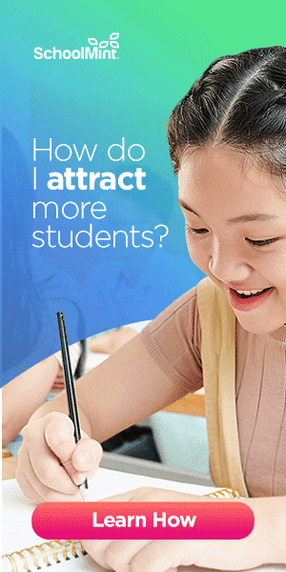Why and How Families Choose K-12 Schools: Reason 4
What makes your K-12 school or district appealing to families? In this fourth installment of a five-part series on why and how families choose schools, you’ll learn the importance of student achievement in whether a family will enroll with you.
In a world of greater choice and innovation across K-12 education, parents and guardians have more say in how and where their children are educated. Why and how do families choose schools? Click here to start at Reason 1: School Brand and Reputation.
When it comes to prospective families and how they choose K-12 schools, student achievement is often the number one factor that determines whether they’ll choose one education option or another one. It’s based on a simple notion: families choose schools that are high-performing because they want their children to achieve similarly.
The Importance of Student Achievement on Parents and Guardians
Families make enrollment decisions often based upon the academic performance of a school. An important factor in creating high-performing schools with positive student outcomes is the delivery of high-quality academic and behavioral instruction in schools and classrooms.
The logical assumption is high-performing schools have great teachers who individualize instruction, have lower class sizes, and will help their children reach their potential.
The Importance of Effective Teachers on Student Achievement

Critical to high student achievement are high-quality teachers. In fact, the quality of teachers, staff, and principals beat out all other factors in a 2018–2019 study by the National Center for Education Statistics that studied how parents choose schools when they have multiple options.
In fact, a highly qualified teacher…
- Is the single most important factor in student achievement as well other important outcomes (Ladd and Sorensen 2016)
- Accounts for a significant portion of the variation in student achievement (multiple studies)
Grow Your Teachers to Improve Student Achievement
To boost student achievement, prioritizing teacher efficacy should be on every school’s agenda for 2022. When teachers can be their best, most effective selves as educators, students will benefit greatly. So what can you do?
- Give educators continual improvement in their knowledge and skills around education best practices. Offer them continued innovation in learning strategies and differentiation.
- Provide teachers with learning tools and software that make their jobs easier. If you can move an existing pen-and-paper system to a digital format, your teachers will save time and energy.
- Implement a support system for teachers. Listen to their concerns, and pair them with a mentor if needed. With mental health and burnout among the top reasons for teacher attrition, supporting them in their roles is more critical than ever.
- Boost each educator’s skills through instructional coaching and personalized professional development. Help them identify areas for instructional improvement while acknowledging the areas in which they excel.
Create High-Quality Instruction Through Feedback
SchoolMint Grow is a teacher coaching and classroom observation platform that makes it easy to give and receive feedback and bring out the best in every teacher.
As an all-in-one digital platform, Grow eliminates the need for manual processes, boosts your efficiency, and can help you see trends in your coaching practices.
With Grow, you get:
- Quick feedback and time-stamped notes
- Lesson plan feedback and video integration
- Customizable rubrics and forms
- Personalized action steps
- One place to manage it all
SchoolMint Grow facilitates the Get Better Faster approach to teacher coaching, and you can read more about it here: Get Better Faster: What is It, and How Does it Work?
While instructional coaching can help you advance your teachers in their profession, coaching alone is only half of what’s required to boost student outcomes.
There’s another half to consider: the relationships you, your teachers, and other faculty build with students.
3 Ways to Boost Student Achievement
Here are three things you can do to build healthy, strong relationships with students and boost their academic outcomes:
1. Provide Academic Feedback
As established, families make education choices based on the performance of the overall student body as well as their own children. And routine constructive feedback is one of the most important tools in the learning process.
Students require frequent, early feedback to maximize mastery. Additionally, academic work should be within a student’s zone of proximal development.
In simple terms, their work shouldn’t be too easy nor too hard. Equally important is that students understand effort is what’s truly important and that failure is part of the learning process.
2. Offer Students Multiple Opportunities to Practice
Students require many chances to practice new learnings and should not be held unreasonably accountable for performance in the early stages of learning.
Otherwise, students are likely to experience a sharp drop in motivation, which is detrimental in these early learning stages.
Further, practice opportunities should be distributed over time rather than mass practice at one time. Distributing the learning over time leads to improved knowledge retention.
3. Build Positive Relationships with Students
Creating positive relationships is one of the most powerful pieces of student retention. Student mentoring has a consistent impact on student achievement as well as on improving attendance — which directly correlates with a reduction in dropout rates.
- At a school, mentors aren’t defined by someone’s position or job description.
- A mentor can be anyone: faculty, advisors, custodial staff, administrative staff, other students, and alumni.
- Essentially, a mentor is anyone who’s willing to invest time and effort in caring about an individual student.
Effective mentoring manifests through a meaningful student-mentor relationship grounded in mutual trust.
Mentors invest themselves in building trusting, supportive relationships with the student. And when students feel safe and supported at school, they’re far more likely to show up, perform well, and graduate.
K-12 Strategic Enrollment Management
Today, enrollment is more than just registering a student in a class. Enrollment is now a strategic process, one that includes several components.
Last week, we talked about the positive climate and culture component. And above, you learned about the student achievement side. Join us next week for the fifth and final installment, when we’ll cover the last reason regarding how families choose K-12 schools!
Share this
You May Also Like
These Related Stories

Why and How Families Choose K-12 Schools: Reason 3

How Can School Leaders Retain Teachers?



